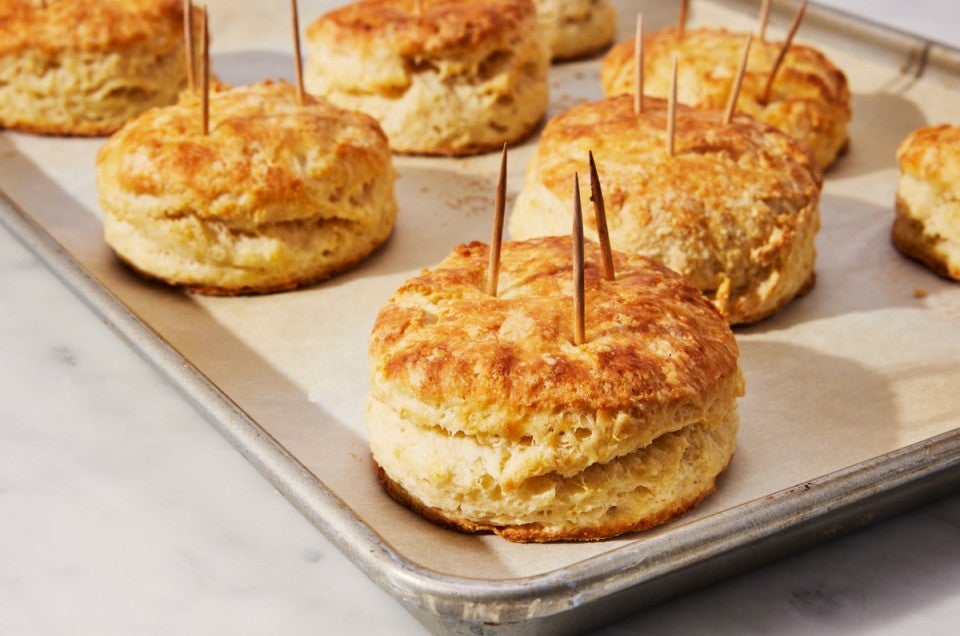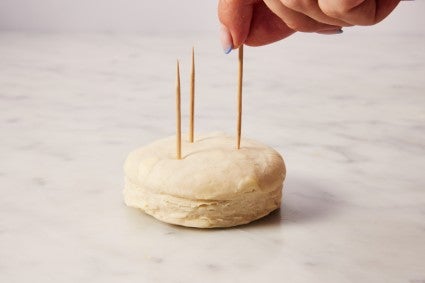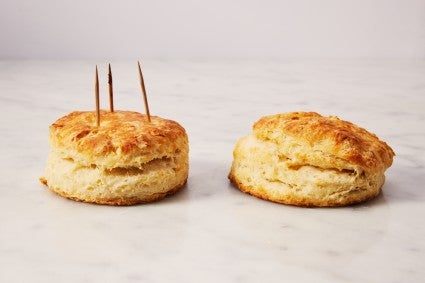Things bakers know: Prevent toppled biscuits with toothpicks
A simple trick for biscuits that rise up instead of falling over.


We all aim to make biscuits that emerge from the oven with flaky layers and tall, golden brown sides. But sometimes, biscuits have other plans, rising unevenly or even toppling over while baking.
I’ve noticed that the flakier and more buttery the biscuit, the more likely it is to misbehave in the oven. Flaky biscuits rise skyward due to butter pockets between layers of dough, which separate and puff during baking so the biscuit can reach impressive heights. But while butter is responsible for those flaky layers and high rise, a buttery biscuit also has a tendency to slump over instead of rising straight up — a phenomenon I've dubbed the “biscuit avalanche.”
Determined to bake statuesque, no-slump biscuits, I began brainstorming solutions to the biscuit avalanche. I noticed that lower hydration biscuit doughs (those with less liquid) tend to hold their shape and rise evenly during baking. But while a drier dough may rise evenly, it also results in a drier biscuit — not ideal. Baking biscuits close together promotes even rising, but doesn’t give the sides of the biscuits much of a chance to brown — I prefer a golden brown surface all around and like to bake my biscuits with space between them for optimal color, so that wasn't the answer, either.

Sometimes, the best solutions are the simplest, and in this case it was the humble toothpick that saved the day. I wondered if toothpicks could provide enough internal support to flaky biscuits during baking to keep them upright. So I put it to the test: I mixed up a batch of biscuit dough, cut out individual biscuits, and placed them on a baking sheet. I left half of the biscuits as is, and then pressed three toothpicks into each of the remaining biscuits.
To my surprise, inserting a few toothpicks into each biscuit before baking did the trick. The toothpicks provided enough structure to help the biscuits rise taller in the oven and kept them from toppling over. I use three toothpicks per biscuit, about a half inch apart, and press them firmly into the dough until they touch the baking sheet. After baking, I remove them before serving.

This technique can be applied to any flaky biscuit recipe; no need to modify the mixing or shaping methods or the bake time, just add the toothpicks! It would be especially helpful when baking these new Pretzel Biscuits, allowing their flaky layers to rise even higher.
This technique has been a game-changer to help me achieve biscuits that look as good as they taste — give it a try the next time you want to avoid the biscuit avalanche, too.
Cover photo by Rick Holbrook; food styling by Kaitlin Wayne.
Biscuits go way back — for the full story, dive into the surprising history of American biscuits.



